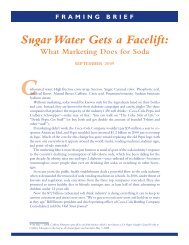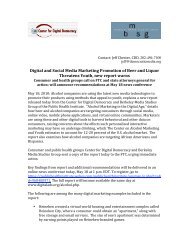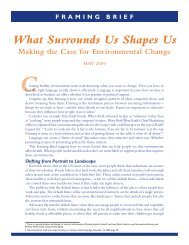"Interactive Food & Beverage Marketing" (PDF)
"Interactive Food & Beverage Marketing" (PDF)
"Interactive Food & Beverage Marketing" (PDF)
You also want an ePaper? Increase the reach of your titles
YUMPU automatically turns print PDFs into web optimized ePapers that Google loves.
<strong>Interactive</strong> <strong>Food</strong> & <strong>Beverage</strong> Marketing | The New Digital Marketing Landscape<br />
“People are spending more time on digital devices and through digital media,”<br />
explained Tim Goudie, group manager, interactive marketing, for Coca-Cola. And because<br />
“a lot this behavior is trackable,” the company is able to use its many online properties to<br />
answer key questions, such as “where are they spending their time… [and] are they doing<br />
what we set them up to do?” 123 For example, the My Coke Rewards program encourages<br />
consumers to use special pin codes from Coke products in order to go online and access<br />
a website, where they can earn a variety of rewards, such as downloadable ring tones and<br />
“amazing sports and entertainment experiences.” According to Coca-Cola’s technological<br />
partner company, Fair Isaac, this “next-generation” promotion is “the most sophisticated<br />
example of how brands can utilize code promotions to capture behavioral and psychographic<br />
information about consumers.” The campaign embodies the company’s “vision”<br />
of “connect, collect and perfect”—“to connect with consumers, collect relevant information<br />
from consumers, and, finally, perfect those relationships over time.” 124<br />
“Location marketing” can track consumers through wireless and other mobile technologies,<br />
enabling marketers to identify where individuals are geographically in the “real<br />
world,” and, in turn, to direct marketing messages to them on the literal spot. Through a<br />
vast data collection and profiling system known as “web analytics,” information about the<br />
online experiences and attitudes of users is compiled in order to influence individual consumer<br />
behavior (such as encouraging purchasing or some form of brand interaction).<br />
Such data, combined with mobile technology’s “right now, right to me” capabilities, will<br />
help fuel “local, targeted advertising” from “the local pizza place” to “national retail<br />
chains and brand advertisers….” 125<br />
The ability to capture data about millions of youth is a key reason why Rupert<br />
Murdoch’s News Corp. (Fox TV) paid nearly $600 million to acquire MySpace last year,<br />
outbidding Viacom’s MTV and others. The popular social networking site boasted 100 million<br />
registered users as of August 2006. One trade publication, reporting on the high-profile<br />
deal, noted that “the digital gold inside of MySpace wasn’t the number of users, but<br />
the information they’re providing,” including “demographic and psychographic data that<br />
Fox <strong>Interactive</strong> can use” to identify “the brand preferences of young people on the<br />
Web.” 126 Marketers have aggressively moved into social networks, taking advantage of<br />
the large, highly detailed user-profiles and expanding lists of “friends” on these sites.<br />
“The targeting we can do is phenomenal,” one industry executive told the press. 127<br />
Search has become a key tool used by youth to seek out information and navigate<br />
the Web. Search engine marketing allows advertisers to target individual consumers<br />
based on the searches they conduct on Google, Yahoo!, Microsoft Network, and other<br />
popular search engine sites. New technologies permit marketers to know the search<br />
terms used to get to a site. They can then quickly add content to a site that reflects the<br />
interest of the users and helps build a relationship. 128 For example, Microsoft’s new MSN<br />
“adCenter” allows marketers to identify “a user’s age, gender, and other demographic<br />
information, based on his or her online behavior.” Microsoft also provides marketers with<br />
the ability to tap into “clickstream” and “search entry” data. Yahoo! offers advertisers a<br />
similar menu of extensive services. According to its promotional materials, Yahoo! has<br />
“become a vital partner” for Frito-Lay, helping the food company “take a bigger bite of<br />
snack food sales.” A full-page ad in Advertising Age displayed a happy Frito-Lay executive<br />
standing in front of a huge display of Cheetos, with Chester Cheetah leaping into the air.<br />
“Frito-Lay has added a special ingredient to its snack line,” the copy read. “It moves chips<br />
off shelves and into grocery bags…. It’s the Yahoo Marketing Engine.” 129<br />
35









